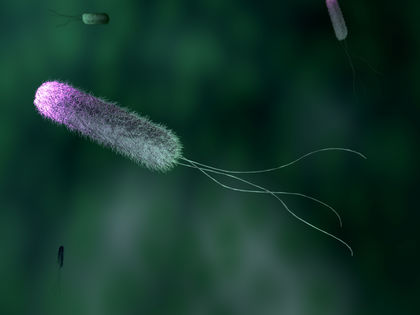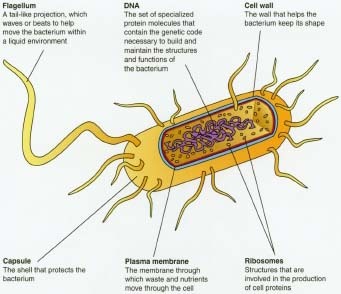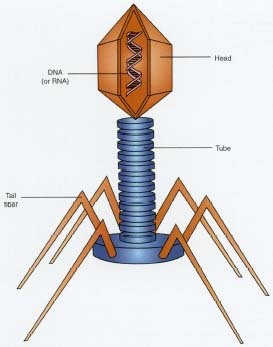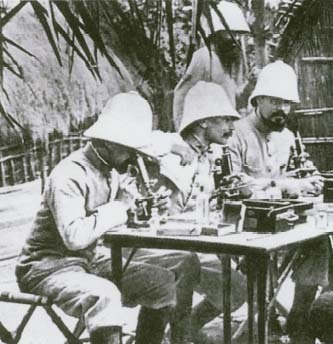The Nature of Germs and Infection

KEYWORDS
for searching the Internet and other reference sources
Bacteria
Fungi
Germs
Immune system
Infections
Infestations
Microbes
Microorganisms
Parasites
Pathogens
Prions
Viruses
What Is a Germ?
A germ is a microscopic organism that can cause disease. The term "microscopic organism" means that it is so small it can be seen only with a microscope. Sometimes also called microbes (MY-krobes), germs can exist just about anywhere on Earth. They can be found in and on animals, plants, and the human body. Some microscopic organisms actually keep people healthy, by helping in the body's digestion and other functions, but others can cause illness.
* syphilis (SIH-fih-lis) is a sexually transmitted disease that, if untreated, can lead to serious lifelong problems throughout the body, including blindness and paralysis.
It was not until the seventeenth century that a Dutch scientist named Antonie van Leeuwenhoek, using an early microscope, was able to describe the existence of these previously unseen creatures. In the mid-nineteenth century the German doctor Jacob Henle advanced a coherent argument that tiny organisms caused disease. His student and fellow German physician, Robert Koch, some decades later used Henle's sequence of evidence to prove that different organisms cause specific diseases. As the nature of germs became more widely understood, scientists began to appreciate that germs cause many common diseases, such as tuberculosis, pneumonia, and syphilis * . By the end of the twentieth century, researchers began to understand how germs can play a role in many chronic * diseases and disorders, including some forms of cancer, disease of the coronary arteries * , peptic ulcer * disease, and chronic lung diseases, which had not been thought of as infections at all.

Microbes generally are classified into three types:
- Commensals (ko-MEN-suls) are organisms that live harmlessly on or in another organism.
- Symbiotes (SIM-be-oatz) are organisms that help each other and, in many cases, need each other for survival, such as bacteria located in the human intestines * that play a crucial role in digesting food.
- Pathogens (PAH-tho-jens) are microbes that can cause damage or disease. This volume on infectious diseases naturally focuses more on pathogens than on commensals or symbiotes.
* chronic (KRAH-nik) means continuing for a long period of time.
* coronary arteries (KOR-uh-nair-e AR-tuh-reez) are the blood vessels that directly supply blood to the heart.
* ulcer is an open sore on the skin or the lining of a hollow body organ. such as the stomach or intestine. It may or may not be painful.
* intestines are the muscular tubes that food passes through during digestion after it exits the stomach.
Germs can be divided into four large groups:
-
Bacteria (bak-TEER-e-uh) are single-cell organisms that do not have a
nucleus. Aerobic (air-O-bik) bacteria need oxygen to survive, whereas
anaerobic (ah-nuh-RO-bik) bacteria do not. But all forms of bacteria,
like all living things, require food for energy and building materials.
Although countless bacteria exist, less than 1 percent of all bacteria
are pathogens.
 This diagram shows the structure of a virus, the smallest infectious agent. Depending on the type of virus, DNA or RNA is wrapped in a protein coat. Because viruses cannot convert food into energy and cannot reproduce on their own, some scientists do not consider them a life form.
This diagram shows the structure of a virus, the smallest infectious agent. Depending on the type of virus, DNA or RNA is wrapped in a protein coat. Because viruses cannot convert food into energy and cannot reproduce on their own, some scientists do not consider them a life form. - Viruses (VY-ruh-sez) are particles containing DNA * or RNA * , which make up the virus's genes * , and are wrapped with a protein coat. Because viruses on their own are not alive, they must invade a living cell and then take over some of the machinery within the host * cell in order to reproduce. Without the living cell, a virus cannot reproduce.
- Parasites (PAIR-uh-sites) are organisms that feed and live on or within another living being. Many parasites enter the body through the intestines or the skin. Single-cell parasites include those that cause malaria (mah-LAIR-e-uh), a disease spread to humans by the bite of an infected mosquito. Parasites with more than one cell include roundworms, flatworms, and so-called flukes. Some parasites, most notably tapeworms, can reach enormous sizes (20 feet or more) inside the human intestines.
- Fungi (FUNG-eye) are more complicated organisms that live in air, in soil, on plants, and in water. Thousands, maybe millions, of species thrive on Earth. Some live in the human body without causing illness. In fact, only a small number are capable of causing disease in humans.
* DNA, or deoxyribonucleic acid (dee-OX-see-ry-bo-nyoo-klay-ik AH-sid), is the specialized chemical substance that contains the genetic code necessary to build and maintain the structures and functions of living organisms.
* RNA, or ribonucleic acid (ry-bo-nyoo-KLAY-ik AH-sid), is the chemical substance through which DNA sends genetic information to build new cells.
* genes (JEENZ) are chemical structures composed of deoxyribonucleic acid (DNA) that help determine a person's body structure and physical characteristics. Inherited from a person's parents, genes are contained in the chromosomes found in the body's cells.
* host is an organism that provides another organism (such as a parasite or virus) with a place to live and grow.
Germs may include other particles as well, like prions (PRE-ons). Prions are transmissible viral-like proteins and are thought to play a role in Creutzfeldt-Jakob (KROYTZ-felt YAH-kub) disease and bovine spongi-form (SPUN-jih-form) encephalopathy (en-seh-fuh-LAH-puh-thee), or BSE. Both of these disorders damage the tissues of the brain, causing a rapid decline in mental function and muscle coordination. BSE, commonly known as mad cow disease, only infects cattle. Prions, which were discovered only recently, are not well understood. Because they lack DNA and RNA, which are common to all other forms of life, it is not clear whether they should be considered to be alive.
What Are Infections?
The word "infection" means something different from "disease," although the two terms sometimes are confused. Disease is a general word that describes any abnormality of the human condition or something that interferes with the normal, healthy functioning of the body. Diseases include infections and infestations, among others. Infection is a term that refers specifically to any abnormal condition caused by a microbe, such as a bacterium, virus, or parasite, that has invaded another organism (like a human) and interfered with some aspect of its function. An infestation is similar to an infection. It refers to any abnormal condition caused by an organism larger than a microbe, such as an insect, louse, or worm. The phrase "infectious diseases" is used to refer to both infections and infestations, regardless of the severity of the condition. An infection beneath a fingernail and a serious case of hepatitis * C both are considered infectious diseases.
The hallmark of many infections is inflammation (in-flah-MAY-shun), which is largely a result of the immune system's * response to infection, irritation, or injury. The characteristics of inflammation include redness, warmth, swelling, and pain. Important players in the immune reaction are the white blood cells. In response to germs, white cells race to the area of infection to fight off the invader; the word "pus" refers to a thick fluid produced by the body in response to an infection that contains these white cells along with other substances resulting from the reaction.
If a disease is contagious (kon-TAY-jus), it can be transmitted from person to person through some form of contact. Not all infectious diseases are contagious, and being exposed to an infectious agent does not mean that a person necessarily will contract an infection. Some people exposed to a contagious organism may not become sick. For example, they might have immunity * to a certain infection because they have had it before or because they had a vaccine * against it.
* hepatitis (heh-puh-TIE-tis) is an inflammation of the liver. Hepatitis can be caused by viruses, bacteria, and a number of other noninfectious medical conditions.
* immune system is the system of the body composed of specialized cells and the substances they produce that helps protect the body against disease-causing germs.
* immunity (ih-MYOON-uh-tee) is the condition of being protected against an infectious disease. Immunity often develops after a germ is introduced to the body. One type of immunity occurs when the body makes special protein molecules called antibodies to fight the disease-causing germ. The next time that germ enters the body, the antibodies quickly attack it, usually preventing the germ from causing disease.
* vaccine (vak-SEEN) is a preparation of killed or weakened germs, or a part of a germ or product it produces, given to prevent or lessen the severity of the disease that can result if a person is exposed to the germ itself. Use of vaccines for this purpose is called immunization.
Infections vary in both how long they last and how severe their signs and symptoms are. Acute infections usually appear quickly and may improve quickly (with or without treatment), but often they can cause immediate discomfort, including extreme tiredness (fatigue), body aches, or coughing. Once the immune system has defeated an acute viral infection,

* cirrhosis (sir-O-sis) is a condition that affects the liver, involving long-term inflammation and scarring, which can lead to problems with liver function.
* antibody (AN-tih-bah-dee) is a protein molecule produced by the body's immune system to help fight a specific infection caused by a microorganism, such as a bacterium or virus.
Chronic infections are those infections that last a longer time—weeks, months, or even years. A chronic infection can develop from an acute infection that does not clear up. Some chronic infections continue to have signs and symptoms, causing discomfort and interfering with life for long periods of time. Other chronic infections may have few or no signs. People who have a chronic infection may not be aware that they still have an active infection and may still be capable of passing the infectious microbe to others. One example is hepatitis C, a disease that can have few symptoms but also can cause cirrhosis * , chronic liver disease, or liver cancer. People with hepatitis C may not be aware that they have it without taking an antibody * test that shows that the body is fighting the virus. Serious signs of liver damage may not show up until 20 years after the initial infection. Latent, or hidden, infections can turn on and off for months or years. One example is the herpes simplex (HER-peez SIM-plex) virus, which can cause infections of the skin, mouth, and genitals * , including cold sores and genital herpes. When the infection is "on," a person can spread it to others.
Many infectious organisms live naturally in and on the human body, often without causing harm, but they can produce disease if they travel to another part of the body. The bacterium Staphylococcus aureus (stah-fih-lo-KAH-kus ARE-ree-us), also known as "staph," normally lives on the skin and sometimes in the mouth and nose of a healthy person. If staph enters the bloodstream, however, it can cause serious and sometimes fatal illness, such as pneumonia or heart infections. Healthy people sometimes can carry germs that cause infections while never contracting the disease themselves. The most famous example was Mary "Typhoid Mary" Mallon, a young cook who unknowingly passed on Salmonella typhi (sal-muh-NEH-luh TIE-fee) bacteria in the food she cooked while working for several New York families in the early 1900s. Many people fell ill with typhoid fever * , but Mary never became sick. Another common example is group B streptococcal (strep-tuh-KAH-kul) bacteria, which can exist in the birth canal of a pregnant woman without causing illness to the mother but can be transmitted to the baby during delivery. Meningococcus (muh-nin-guh-KOH-kus) bacteria, too, can live harmlessly in one person's nose and throat but can cause deadly disease in another. When a person without symptoms has a germ that can be transmitted to others, that person is called a carrier.
In other cases, people may have an immune system that is not working completely, a condition known as a compromised immune system. This problem is most common among the elderly, newborns, and those patients with certain chronic illnesses, diseases that affect the immune system directly, or some genetic * factors. Such people may become sick from an infection because their body defenses cannot fight off the germs as well.
* genitals (JEH-nih-tuls) are the external sexual organs.
* typhoid (TIE-foyd) fever is an infection with the bacterium Salmonella typhi that causes fever, headache, confusion, and muscle aches.
* genetic (juh-NEH-tik) refers to heredity and the ways in which genes control the development and maintenance of organisms.
* spores are a temporarily inactive form of a germ enclosed in a protective shell.
* intravenous (in-tra-VEE-nus) or IV, means within or through a vein. For example, medications, fluid, or other substances can be given through a needle or soft tube inserted through the skin's surface directly into a vein.
* transfusions (trans-FYOO-zhunz) are procedures in which blood or certain parts of blood, such as specific cells, are given to a person who needs them because of illness or blood loss.
How Germs Spread
Germs can spread through a number of ways. Examples include:
- aerosol spread, such as when tiny droplets of fluid are coughed, laughed, or sneezed into the air and are inhaled by another person or when fungal spores * are stirred up by wind or construction and are breathed in by people in the area
- sexual and intimate contact, sometimes including kissing
- direct contact, such as touching a fungal infection on a person's body or stepping on a parasite while walking barefoot outside
- contact with fomites (surfaces or non-living objects), such as when an infected child sneezes on a toy and then another child plays with the toy and places it in his or her own mouth
- blood contact during intravenous * drug use or, rarely, transfusions *
- contaminated foods and water, which can transmit harmful bacteria, viruses, and parasites when people eat the food or drink, swim, or play in the water
- the fecal-oral route, which spreads germs when people come into contact with feces (FEE-seez, or bowel movements) from someone who is infected and then touches the mouth, such as when day-care workers pass diarrhea (dye-uh-REE-uh)-causing rotavirus (RO-tuh-vy-rus) from one infant to the next between diaper changes
- pregnancy, birth, and breast-feeding, which can spread some infections from mother to baby
- animal or insect bites, such as those of mosquitoes (the most common insect vector * ), fleas, and ticks
* bacteriologist (bak-teer-e-OL-o-jist) is a scientist who studies bacteria.
* culture (KUL-chur) is a test in which a sample of fluid or tissue from the body is placed in a dish containing material that supports the growth of certain organisms. Typically, within days the organisms will grow and can be identified.
* vector (VEK-tor) is an animal or insect that carries diseases and transfers them from one host to another.
Koch's Postulates
Robert Koch (1843-1910), a German scientist and bacteriologist * , was the first researcher to use microscopic examinations a.d scientific methods to identify germs as the causes of specific diseases. Koch's postulates (POS-chuh-lits), which Koch had learned from his teacher Jacob Henle, are used to prove that an organism is responsible for a certain illness. These are the four criteria:
- The germ should be present at the site of infection for all animals that have the disease in question.
- The germ should be isolated from the sick animal; that is, grown in a pure culture * from a sample from the infected site.
- When the pure culture is introduced into a healthy animal, the germ should trigger the same disease.
- It should be possible to recover the germ from the experimentally infected animal.
See also
AIDS and HIV Infection
Common Cold
Creutzfeldt-Jakob Disease
Helicobacter Pylori Infection (Peptic Ulcer Disease)
Hepatitis, Infectious
Herpes Simplex Virus Infections
Immune Deficiencies
Malaria
Pneumonia
Sexually Transmitted Diseases
Staphylococcal Infections
Tuberculosis
Vaccination (Immunization)
Resources
Organization
U.S. Centers for Disease Control and Prevention (CDC), 1600 Clifton
Road, Atlanta, GA 30333. Through the website of the National Center for
Infectious Diseases, the CDC provides information on the spread of germs
and the prevention of infectious diseases, along with information about
specific diseases.
Telephone 800-311-3435
http://www.cdc.gov
Website
KidsHealth.org
. KidsHealth is a website created by the medical experts of the Nemours
Foundation and is devoted to issues of children's health. It
contains articles on a variety of health topics, including the nature
and spread of germs and how to avoid infectious diseases.
http://www.KidsHealth.org